1. Memorial house of late General Secretary Truong Chinh
The memorial house of the late General Secretary Truong Chinh is located in Hanh Thien village, Xuan Hong commune, Xuan Truong district. General Secretary Truong Chinh, an excellent student of President Ho Chi Minh, left a great mark in the history of Nam Dinh red soil. This memorial house is not only a place to remember famous leaders but also a place to preserve many important local historical events.
The memorial house for the late General Secretary Truong Chinh was originally built by his grandfather in the year of the Tiger, the 4th year of Thanh Thai (1902), for Mr. Dang Xuan Vien (Bon De), father of General Secretary Truong Chinh. The house is a space containing many memories of the revolutionary activities of the Party Committee and people of Nam Dinh in the period 1928-1954. This place used to be a printing facility for revolutionary documents and a place to hide Comrade Truong Chinh during his vacations from the battlefield back home.
The house is made of ironwood, has 5 rooms, a set of upper and lower beams with seven rows of rafters, and a male-tiled roof. Previously, this place had a card door and is now maintained with spacious space. The memorial grounds are preserved and developed, with a large house, guest house, and large garden space. The system of small ponds, perennial trees, and ancient brick gates represent traditional style.
The Party Committee and people of Nam Dinh have made efforts to preserve and develop the memorial house of late General Secretary Truong Chinh, renovating this space into a spacious place. Currently, the memorial house of late General Secretary Truong Chinh includes a memorial house (church), guest house, and harmonious garden spaces, preserving tradition as well as historical and cultural values.
 Souvenir relic of General Secretary Truong Chinh
Souvenir relic of General Secretary Truong Chinh
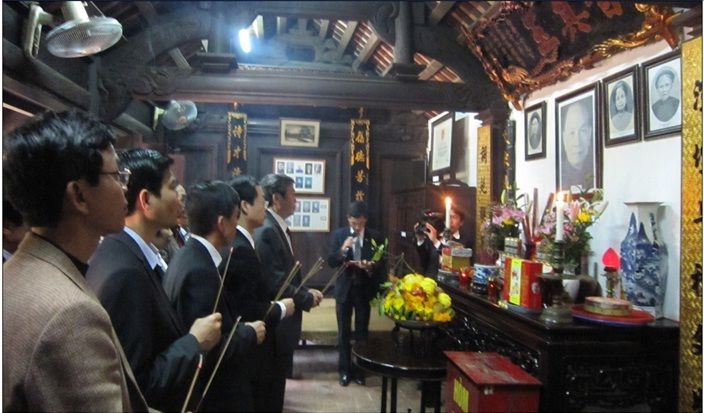 General Secretary Truong Chinh’s Historical Museum
General Secretary Truong Chinh’s Historical Museum
2. Phu Nhai Cathedral (Phu Nhai Minor Basilica)
Phu Nhai Church is located in the center of Xuan Phuong commune, Xuan Truong district, Nam Dinh province, more than 1 km from Xuan Truong town. This is one of the largest religious architectural works in Vietnam. Originally built of wood and roofed with leaves, construction was started by parish priest Emmanuel Riano Hoa in 1866, right after King Tu Duc issued a decree to change religion, ending nearly 3 centuries of Christian oppression in the country. Vietnam.
In 1881, Bishop Hoa and Father Barquerô Ninh built a second church in the Asian architectural style and two bell towers. In 1916, Bishop Peter Munagori Trung and priest Moreno began building the third church in Gothic style. Although it was inaugurated in 1922, it was severely damaged by a major storm on June 24, 1929. Finally, after many difficulties, the church was restored and completed on the feast of the Immaculate Conception. Original Sin, December 8, 1933. During the war, Phu Nhai church became an important strategic point, occupied and used for military purposes by the French army.
With original Spanish Gothic style architecture, the church has large dimensions: 80 meters long, 27 meters wide, 30 meters high. Two 44-meter high bell towers hold 4 bells cast from France, weighing 2,000 kg – 1,200 kg – 600 kg and 100 kg respectively. The front of the church has a 17m high statue of Saint Dominic and a 15m high mausoleum storing the remains of 83 martyrs of the Phu Nhai parish. Around the church are bas-reliefs showing the 14 Stations of the Cross. From the top of the church tower, visitors can enjoy panoramic views of Xuan Truong District. In 2008, Phu Nhai Temple was upgraded to a Minor Basilica.
 Phu Nhai Church
Phu Nhai Church
 Inside Phu Nhai church
Inside Phu Nhai church
3. Keo Hanh Thien Pagoda
Keo Hanh Thien Pagoda is located in Hanh Thien village, Xuan Hong commune, Xuan Truong district, Nam Dinh province. This is one of the ancient pagodas in Vietnam that has kept its 400-year-old architecture intact. The pagoda’s architecture has great influence from Keo Pagoda in Thai Binh. In front there is a semicircular lake creating a calming space. Keo Hanh Thien Pagoda consists of 13 large buildings with 121 consecutive compartments, combining the internal three-door architecture in the style of stacking matches, 7.50 m high. In the pagoda, ancient relics from the 17th century such as tablets, altars, dharma statues, bells, ancient stele, horizontal plates, parallel sentences and Chinese books are kept.
In front of the Three Entrance Gate, there is a semicircular lake, a three-mountain rockery and a pair of giant stone elephants. The three-door architectural bell tower is 7.5 m high with artistic patterns of the Later Le period. Behind the bell tower is the front hall, the second court and the first court worshiping Buddha and Zen Master Khong Lo.
The Spring Festival and the September Festival are important events at the temple. The Spring Festival includes duck catching games, firecracker throwing competitions, rice cooking competitions and folk music activities. The September festival is religious with rituals and is an occasion for the spiritual and cultural convergence of agricultural residents. Every year, people from all over come to participate in the Keo Hanh Thien pagoda festival, showing their loyalty and pride in the local’s enduring cultural heritage.
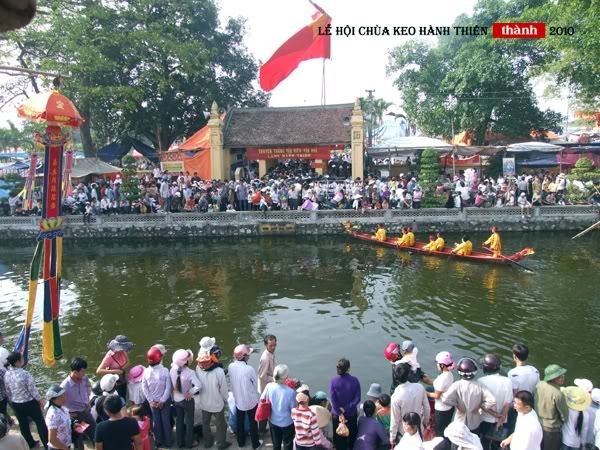 Keo Hanh Thien Pagoda Festival
Keo Hanh Thien Pagoda Festival
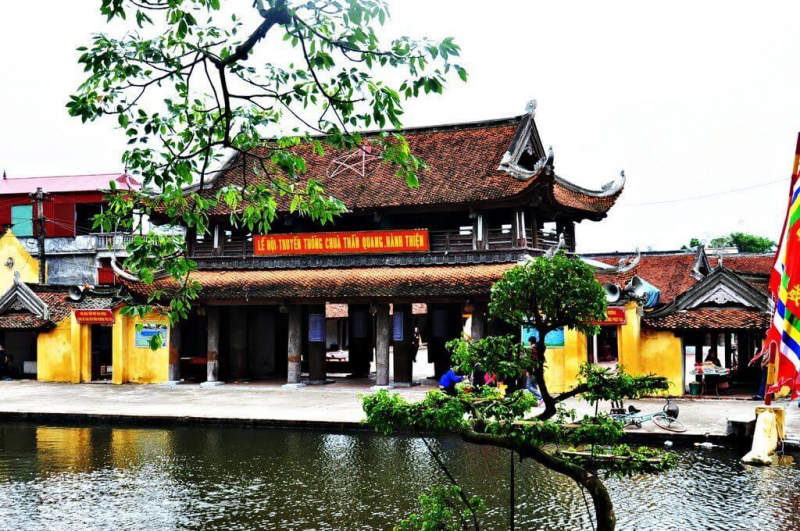 Keo Hanh Thien Pagoda
Keo Hanh Thien Pagoda
4. Xuan Bang Temple
Xuan Bang Temple in Xuan Truong town commemorates General Ngo Mien, a leader who publicly destroyed land and brought people back to build. General Ngo Mien was born in Mai village, Xuan Phuong commune, Kim Hoa district, Kinh Bac town in the second year of King Tran Nghe Tong’s reign (1371).
Xuan Bang Temple is also a place to worship two brothers Do Than Doan and Do Nhan Tang, two young mandarins who made great contributions under the reigns of King Le Hy Tong and Le Du Tong. Built in the 22nd year of King Tu Duc’s reign (1869), the temple is preserved with the main temple and small buildings such as the ruler house, flag house, stele house, orphanage, writer’s office… combined. with a system of walls and an airy garden.
This relic has very sophisticated stone carvings, showing folk life, landscapes and animal images. Xuan Bang Temple is a symbol of the spirit of solidarity and indomitable resistance against foreign invaders of the past and present Xuan Bang people. With its unique historical and architectural value, it attracts visitors to participate in the annual festival and learn about this land.
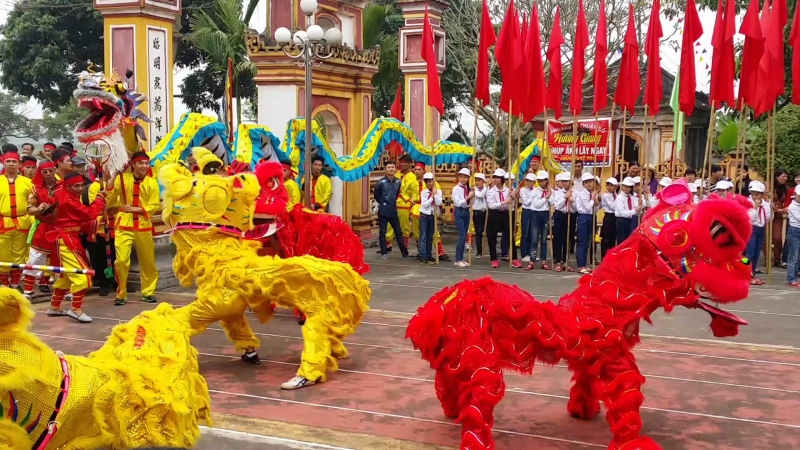 Xuan Bang Temple
Xuan Bang Temple
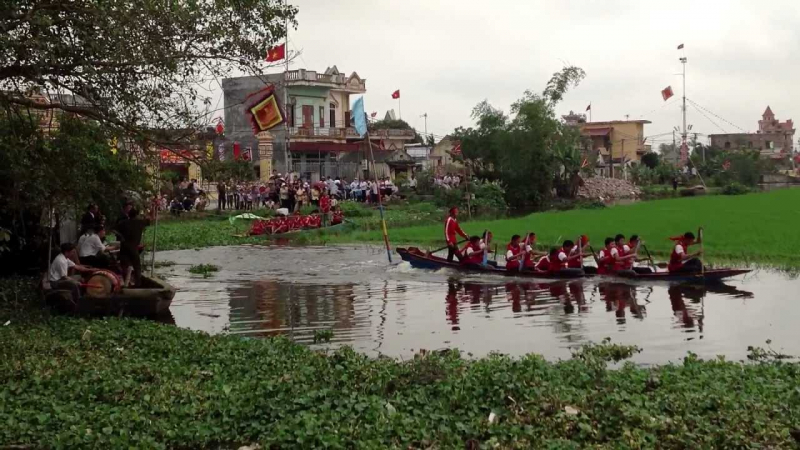 Xuan Bang Festival
Xuan Bang Festival
5. Bui Chu Church
Bui Chu Cathedral is located in Xuan Ngoc commune, Xuan Truong district, Nam Dinh province. This church is the main building of Bui Chu diocese, preserving the historical imprint of East-West missionary and cultural exchange. Built in Baroque architectural style under the chairmanship of Spanish bishop Wenceslao Onate Thuan (1884), the church is 78m long, 22m wide, 15m high, and has two 35m high bell towers. The ancient clock, ordered from France in 1922, still works after more than 100 years. Every year on August 8, the patron saint’s day, many parishioners come here to celebrate mass. In 2019, Bui Chu Diocese announced the demolition (dismantling) of the church to build a new one with similar architecture. On February 4, 2020, the downfall was made to begin construction of the new church.
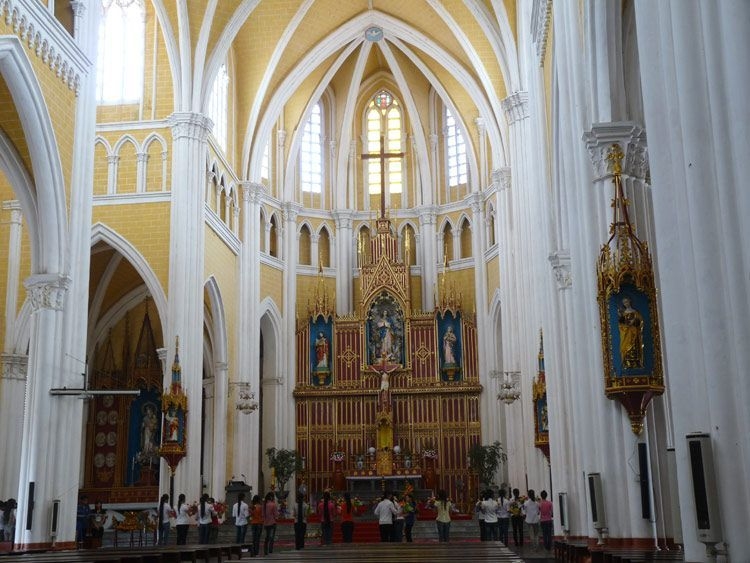 Bui Chu Church was built in Baroque architectural style
Bui Chu Church was built in Baroque architectural style
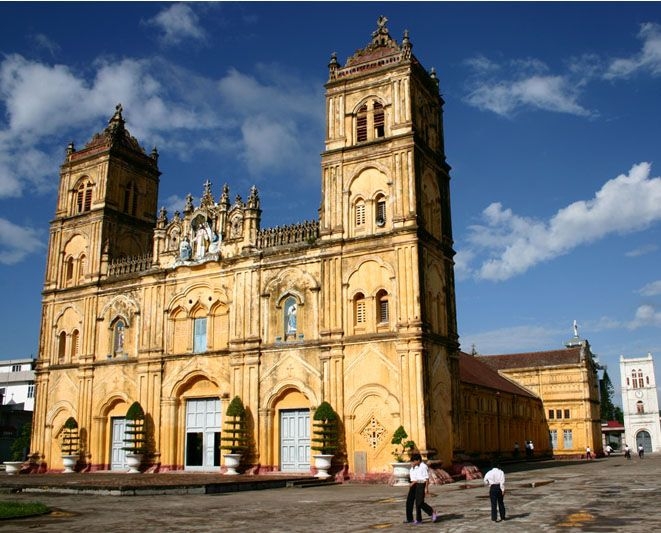
Bui Chu Church
6. Xuan Hy Temple
Xuan Hy Temple , also known as Ha Temple, is located at the end of Xuan Hy village, Xuan Thuy commune, Xuan Truong district. The temple was built to worship Dai Duc – Ngo Mien, who was responsible for reclaiming the sea and building hamlets. Ngo Mien, nickname Dai Duc, was born in the year of the pig during the reign of King Tran Nghe Tong (1371). From a wealthy family, he chose to return to his hometown to open a school and work to explore coastal land. At the end of the village, the temple is located on a large area of land, in front of the temple is a rectangular lake, surrounded by rice fields. The temple area includes four front halls, three middle halls and one back hall. The villagers organize the festival on the 20th, 21st and 22nd of the 8th lunar month with many exciting games such as ‘pulling and gleaning for fire to blow rice, swimming for men and women around the village’. The festival attracts residents and tourists to participate.
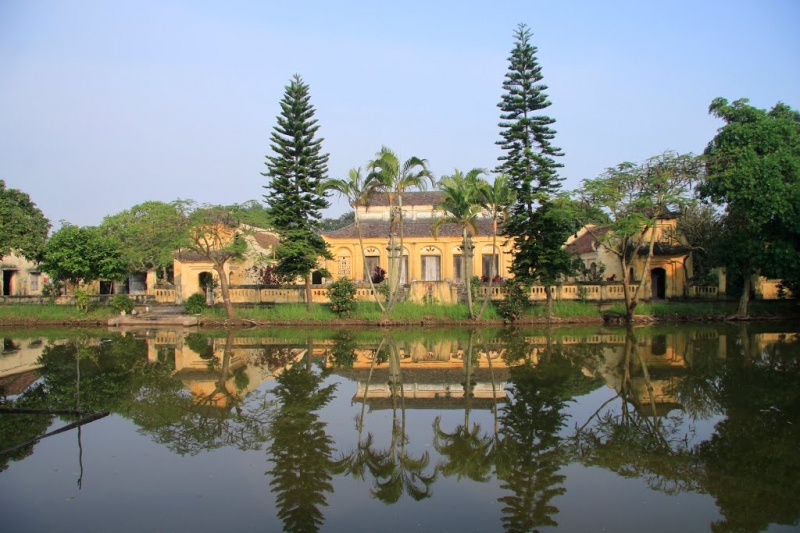
Panorama of Xuan Hy Temple
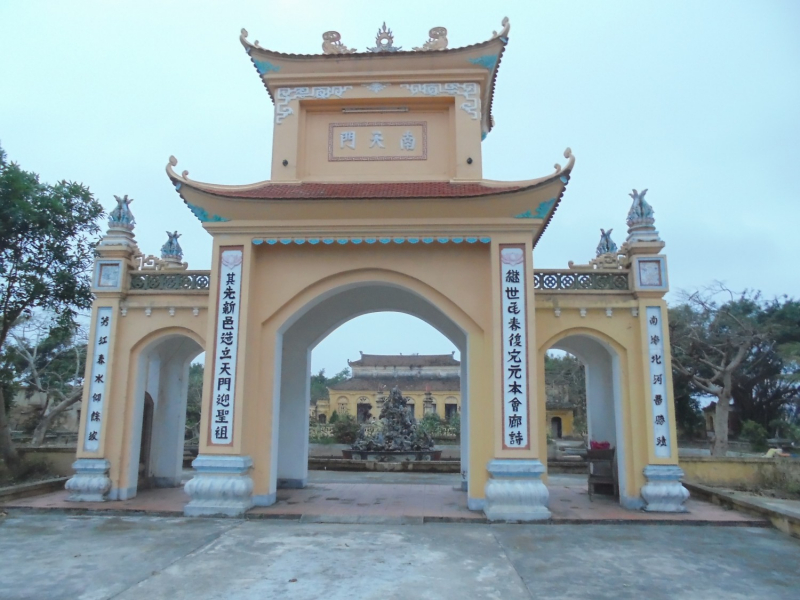
Xuan Hy temple gate
7. Tho Vuc temple and pagoda
Tho Vuc temple and pagoda in Xuan Phong commune, Xuan Truong district, Nam Dinh province, are national historical architectural relics. Not only is it a relic complex with cultural and artistic value, but it also has historical significance. During the resistance war against the French, this was the meeting place and activities of Communist organizations. Tho Vuc Temple and Pagoda are still a complex of sacred religious works, restored and preserved by local people.
Tho Vuc Temple worships 5 saints – gods, including the Village God Emperor and the Nam Hai Dai Kings. The temple was built a long time ago and has undergone many restorations. In 1924, the temple was rebuilt as tall as it is today, made of concrete bricks and tiles. Tho Vuc Pagoda was completed in March 1724, Bao Thai era. The entire relic complex is designed according to traditional architecture, preserving many precious relics such as dharma statues and worship objects of high artistic value.

Tho Vuc temple and pagoda
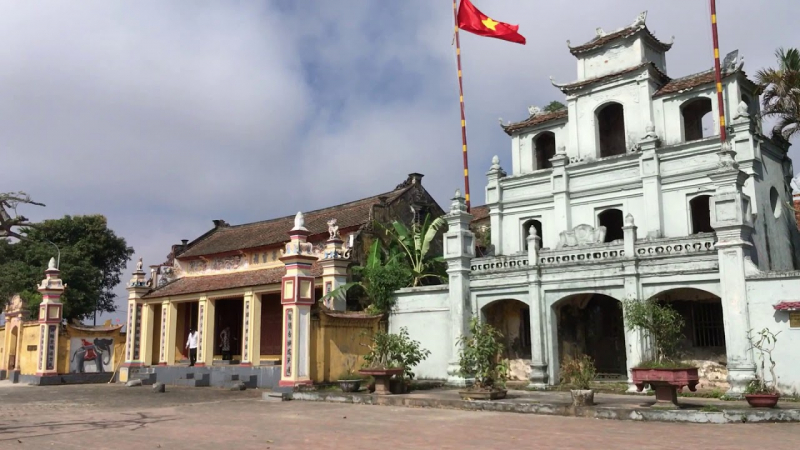
Tho Vuc temple and pagoda
8. Nghia Xa Pagoda
Nghia Xa Pagoda (Vien Quang Pagoda) is a large and majestic relic. Domestic and foreign work, on a land area of about 500 m2. The pagoda has been moved and repaired many times, but the architectural imprint of the Later Le Dynasty is still quite bold in the construction style and engraving style such as 2 sets of Tien Bai house doors, dozens of lotus stone feet. Stone tower tomb area… Here, there is also a stele from the Ly Dynasty engraved in 1122, which is one of the rare stele in the locality. In addition, at the pagoda there are three palanquins, many incense burners and carved wooden crocodiles of the Later Le period that have artistic value. Nghia Xa Pagoda also has a famous landscape.
Nghia Xa Pagoda currently worships Buddha and the Saints. In front of the pagoda, Zen Master Tue Tinh is worshiped. According to local elders, before 1949, the pagoda had many Buddha statues, but later they were destroyed by the French invaders. Currently, the front pavilion worships the statues of Pho Hien and Quan Cong, the second pavilion has the Cuu Long court, the Upper Pavilion worships four statues of Avalokiteśvara, and a statue of Amitabha sitting in a meditating position. At the top of the upper shrine are three statues of three generations. If looking from the outside into the upper palace, the room is next to it (right side). There is a tablet worshiping King Ly Than Tong, next to it there is a tablet worshiping Luc Thuong Thai Su. Next to the temple statue on the left side is a tablet worshiping Zen master Giac Hai and an adjacent space has a tablet worshiping Nguyen Minh Khong. Behind this upper palace, there are 4 compartments (taking advantage of the upper palace roof) with 4 statues corresponding to the people who are worshiped outside. During the period of resistance against the French colonial invasion, many memorable historical events took place at the monument. In 1946, the French colonialists returned to invade our country again, Nghia Xa Pagoda was the place where militiamen rested and practiced for years. Also during this time, monk Nguyen Thanh Tac, the abbot at the pagoda, took off his Ca Sa shirt to join the national defense group to fight against the French colonialists.
During the period of 1947 – 1948, Nghia Xa pagoda was the place where the Viet Minh province of Nam Dinh province continuously went to organize mass meetings. There were large rallies such as the rally of the three southern districts of the province, Xuan Truong, Giao Thuy and Hai Hau. On the occasion of International Labor Day on May 1, 1950, the Party flag flew on the temple bell tower even though this place was still temporarily occupied by the enemy. Nghia Xa Pagoda (Vien Quang) is one of the valuable relics of Nam Dinh province.
Every year, on the 1st day of the third lunar month, the local government and people of Xuan Ninh commune solemnly organize a traditional festival to honor the historical and cultural significance of the relic, and thereby also evoke The sense of pride of the local people and the generosity of local guests inside and outside the commune to repair and embellish the relic site are becoming more spacious, cleaner and more beautiful.
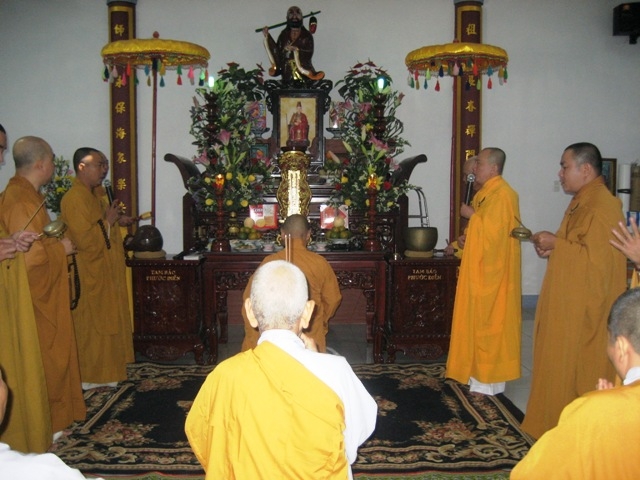
Nghia Xa Pagoda

Panoramic view of Nghia Xa pagoda
9. Xuan Trung Pagoda
Xuan Trung Pagoda ‘s literal name is Linh Quang Tu (Linh Quang Pagoda) in Xuan Bac commune, Xuan Truong district. Based on the document ‘Tra Lu Xa Chi’ compiled by Bachelor Le Van But in the first year of King Khai Dinh’s reign (1916), Xuan Trung Pagoda was built in 1720 during the reign of King Le Du Tong. The first person who contributed to the construction of the pagoda was Mr. Dao Cong Canh, from Nguyet Giam village, Minh Tan commune, Kien Xuong district, Thai Binh province. The original temple had a small architectural scale, a thatched roof, and surrounding walls covered with earth. In 1785, Xuan Trung Pagoda was officially built in a spacious manner. By the second year of King Gia Long’s reign (1803), the pagoda had a large scale, with over 80 large and small compartments. The inscription on the stone altar, written in the 33rd year of King Tu Duc’s reign (1880), currently hanging at the altar hall, praises the beauty of the pagoda as follows: ‘Linh Quang Pagoda is located in Trung village, Tra Lu commune, Giao district. Thuy, Xuan Truong Palace is a beautiful landscape in the region, a place where many colors gather.
Through many years of formation and development, Xuan Trung Pagoda has always been preserved and embellished by Party committees, authorities, generations of monks and local people. Xuan Trung Pagoda today, in addition to worshiping Buddha, also worships Ly Dynasty Zen master Nguyen Minh Khong (1076-1141). The Zen master is from Dam Xa (Diem Xa) in Trang An, his real name is Nguyen Chi Thanh. As a child, he worked as a farmer, then became a monk at Quoc Thanh Pagoda, taking the name Minh Khong. Nguyen Minh Khong is a man with a profound education and famous for magic, with a tendency to practice esoteric teachings: ‘There are miracles of flying in the air, walking on water, defeating dragons and tigers’.
Legend has it that King Ly Than Tong suffered from a strange illness, was mentally disturbed, his body was covered in patches, and his mouth always roared like a fierce tiger. The famous doctors were helpless, the Mother of God and the Queen were all afraid. Hearing of Zen Master Khong Lo’s reputation, the National Mother personally invited him to her palace for treatment. The Zen master used magic to cure the king’s illness. The king appointed him National Teacher and gave him many benefits. The current architectural work of Xuan Trung Pagoda is built in the style of ‘inner script, foreign script’, facing west on an area of 6,125 m2.
The overall project includes many items, its massive scale and appearance still preserves many architectural and artistic features of the post-Le period of the 17th – 18th centuries. Located in front of the pagoda is a system of three gates built in a matchmaking style with two floors and four roofs, roofed with male tiles. On both sides of the three-entrance gate are a bell tower and a bell tower, built in the style of a ‘village gate’ with soft curved corners. After the three gates, through a large yard paved with clean red tiles, you will reach the main pagoda. The Dinh-shaped structure includes a five-compartment pavilion, 13 m long, 8.70 m wide, and a five-compartment three-storey temple, 12 m long, 5.30 m wide. The frame of the building is made of ironwood in the style of a ‘gong stand’ with the following components: head beam, hitch beam, front beam, back trap all machined in a circular shape.
This is a special feature in the architecture of the Later Le period of the 17th – 18th centuries that is still preserved at the monument. Besides the main pagoda, there is also a temple worshiping Zen Master Nguyen Minh Khong, a temple worshiping Saint Mother Lieu Hanh, behind is the ancestral house and surrounded by a system of guest houses, monk rooms… All have formed a closed whole. The completion has increased the architectural and artistic value of the relic site. From its typical values of history and artistic architecture, Xuan Trung Pagoda in Xuan Bac commune has been ranked by the Ministry of Culture and Information as a historical architectural and artistic relic.
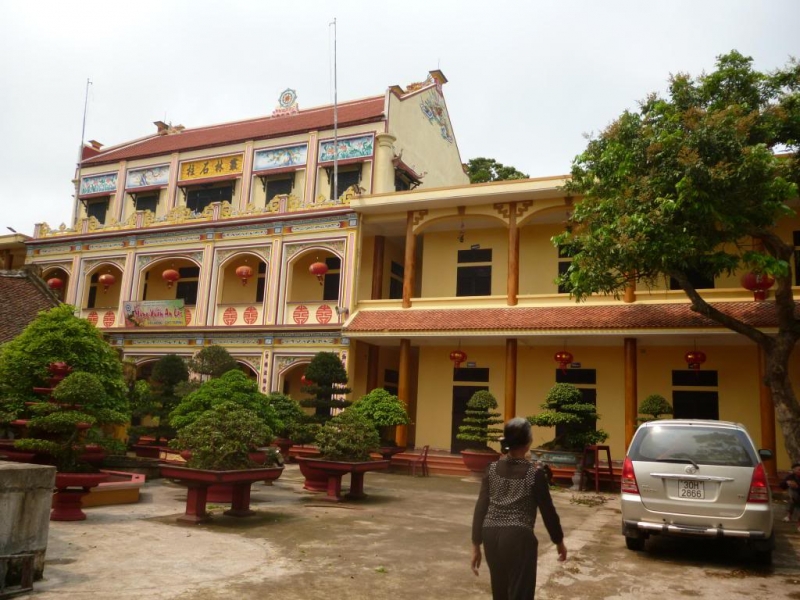
Xuan Trung Pagoda

Xuan Trung Pagoda
10. An Cu Temple
An Cu Temple in Xuan Vinh commune, Xuan Truong district, Nam Dinh province is a relic built by local people to mark the sea reclamation efforts initiated by the founder Phuc Dien in the late 14th century. According to the divine genealogy currently kept at the relic, the ancestor Phuc Dien belonged to the Vu Hon lineage, originally from Mo Trach, Hai Duong province. He is the son of Mr. Phuc Dien, who is credited with founding the land of Binh Cu, now Xuan Ngoc commune, Xuan Truong district. Phuc Dien’s ancestor was a member of the brocade family and was educated and had more intelligence than others. He realized that the land of Binh Cu was difficult to make a good business, so he needed to explore the southern sea. For many years, under the direction of Phuc Dien’s ancestor and the efforts of the people, a large area of land was reclaimed. The villagers named the new land An Cu, implying stable living. The merits of Phuc Dien’s ancestor to the people here were extremely great, so after his death he was honored as ‘Khai An Ancestor’ (the ancestor who opened the new land). People worship him as a god in the temple. Currently, at the temple, there are still a pair of parallel sentences recording his merits: ‘The spirit of the land rises up the castle, the music and rituals of ancient times prosper. An Cu Hung Vu Temple is famous for its treasures and earthly objects. (Building castles on sacred land, ceremonies, music, clothes, and hats have always flourished. Restoring the Vu Temple in An Cu, reputation, wealth, and people are all prosperous).
An Cu Temple is currently facing southeast and includes many symmetrical construction items. In front of the temple is a ceremonial gate system forming three entrance gates. The middle gate is shaped by two bronze pillars over 7 meters high, the two side gates are built symmetrically in the style of a stack of eight matches and are roofed with imitation tube tiles. The main structure of the temple is built in three layers forming a triangular plan including: Front hall, middle hall and rear palace. The front hall has 5 high and wide compartments, all components including beams, trusses, and first beams are made of ironwood. Supporting the roof are masonry walls and a solid brick column system. In the middle of the front hall, there is a scroll embossed with three Chinese characters ‘Opening the foundation’ (the ancestor who opened the new land). Next are the 5 middle halls built adjacent to the front hall. The central roof is made of arched style with male tiles.
In the middle of the hall hangs a gilded hammock door with themes of dragons, cups, turtles, phoenixes and flowers in the artistic style of the Nguyen Dynasty. An Cu village festival, in addition to ritual ceremonies and palanquin processions, the village also organizes many games such as wrestling, swimming, Chinese chess, tom whore nest… Especially in An Cu village festival, wrestling and swimming games are held. Brushing is never lacking in any year. This is a way for villagers to exercise and work hard in production. Since ancient times, An Cu wrestling has been very famous. On village festivals, many wrestlers from many localities came to register to compete such as: Bac Ninh, Thanh Hoa, Ha Tay, Hai Phong… Therefore, An Cu village festival is always bustling with the martial spirit of a coastal village. Coming to An Cu wrestling, wrestlers in all parts of the country know about ‘fighting the gong’. It is a dangerous martial art that only An Cu can successfully apply.
Previously, during the Nguyen and An Cu dynasties, there was a wrestler Kinh who used a gong to compete in Thanh Hoa and defeated many opponents, winning the championship title, making other wrestlers admire him. Currently, the martial spirit among villagers is always maintained and developed by the locality. The entire An Cu village currently has over 30 wrestlers, of which hamlets 4 and 16 are the most famous, contributing to Nam Dinh province’s sports with many outstanding athletes every year. The traditional festival at An Cu Temple is a very practical cultural activity, with traditional educational significance and encouragement to the masses to work hard and produce. Surely the traditional festival at An Cu temple will attract the attention of many people near and far, contributing to promoting the value of a relic recognized by the State.

An Cu Temple

Traditional festival of An Cu Temple